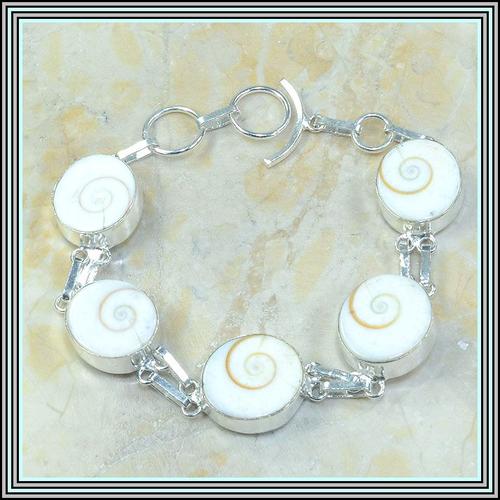Certain bivalve (two-shelled) mollusks, like some mussels and oysters, create pearls as a reaction to an irritant that has found its way inside the shell. In nature, this irritant may be microscopic, such as a parasite. The mollusk secretes nacre, the same material used in shell-building, and over time the nacre builds up to create a pearl. Natural pearls may not necessarily be perfectly round. The longer the mollusk works to create the pearl, the greater the chances of its being misshapen or pitted. Both saltwater and freshwater mollusks make pearls.
BIWA SHELL 17 X 20 MM SET IN 925 STERLING SILVER 18-22 CM ADJUSTABLE BRACELET
Check my rate
| Main centres: | 1-3 business days |
| Regional areas: | 3-4 business days |
| Remote areas: | 3-5 business days |
Product information
PLEASE SUPPORT SMALL BUSINESS MANUFACTURES - BUY LOCAL FOR THE BENEFIT OF ALL - BUY SOUTH AFRICAN
ROXSHELL'S GEMSTONES
BITS n PIECES RANGE
PRESENTS

BIWA SHELL
17 X 20 MM
925 STERLING SILVER
18-22 CM ADJUSTABLE BRACELET
Biwa pearls are small, unusually shaped cultured pearls from the freshwater mussels of Lake Biwa, Japan. First produced in the 1930s, their quality rivalled that of both natural and cultured saltwater pearls, and they were far less expensive to own. For many years any freshwater pearl was called a Biwa, regardless of its provenance.
Biwa, or freshwater pearls, consist of solid pearl material, or nacre, whereas ocean pearls usually have only a small layer of nacre over a large mother of pearl centre (cultured). Cultured ocean pearls have less healing energy. Biwa pearls are higher quality freshwater pearls and may be natural or cultured. Cultured pearls have only a very thin coating of the pearl material (nacre) and therefore have a mixed energy vibration. Natural pearls are much better for healing work.
About Pearls
Culturing Pearls
When technicians introduce an irritant into a mollusk's shell, it protects itself with nacre as usual, and the result is a "real" pearl. However, the irritant is much bigger than a grain of sand or a parasite. Saltwater mollusks are seeded with a small round bead of shell material (mother-of-pearl), plus a piece of mantle tissue from the mollusk itself, which carries the cells that prompt nacre production. Cultured saltwater pearls therefore, start out larger, have a non-nacre centre, are uniformly rounder and are ready for harvest sooner than a natural pearl.
Biwa Characteristics
- Biwa's Decline
Kokichi Mikimoto is the man most credited with perfecting the techniques of freshwater pearl culturing. He and his associates, experimenting at Lake Biwa, seeded mussels only with soft mantle tissue. This resulted in an all-nacre pearl of good lustre and unusual shape---the rice-grain shape was typical. Biwa pearls also emerged in previously unseen colours, and they could be mass-produced. Technicians could plant many bits of mantle tissue in one mussel, and harvest 15 or 20 small pearls from each. From the 1930s on, Biwa set the standard for freshwater cultured pearl quality, and made pearls more affordable than they had ever been.
- Biwa Pearls Today
Biwa pearls came on the market just when the natural, saltwater pearl fishing industry was going into serious decline. Overfishing and pollution had damaged mollusk beds, especially in the Persian Gulf. By the 1930s, the oil industry there also tempted workers away from the great dangers of pearl diving to safer jobs on land. In less than 50 years, however, Biwa pearl production also declined, thanks to similar factors---pollution at Lake Biwa and fresh competition from abroad, especially China.
Today, Biwa's pearl production is negligible. China's huge natural and labour resources have put it at the forefront of cultured pearl production, and "Biwa" pearls sold from Japan today sometimes are produced in China. Legally in the U.S., however, no pearl may be sold as Biwa unless it comes from Lake Biwa. Older examples remain the best
COMES WITH COMPLIMENTARY GIFT BAG
WHICH EVER PIECE YOU CHOOSE LET IT PUT A BOUNCE IN YOUR STEP AND INSPIRE YOU TO TAKE THAT ONE LAST GLANCE IN THE MIRROR BEFORE YOU WALK OUT THE DOOR
BE UNIQUE
BE IN STYLE
BE IN FASHION
If for a valid reason you are not satisfied with the product you purchased Return the product and We will refund your money excluding postage.

